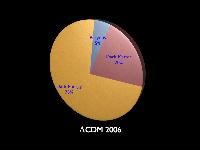

We may be a priveleged generation: the first in history to know the right answers to the big questions. According to Einstien's theory of General Relativity, the universe can not be static and eternal - it must either expand or contract. This was such a remarkable prediction that Einstein himself tried to deny it, inserting a fudge factor into his theory - the "cosmological constant" - to hold the universe steady. A decade later, Hubble discovered that the universe was in fact expanding. Einstein repudiated the cosmological constant as his "greatest blunder" and Big Bang cosmology was born.
Big Bang cosmology provides the modern framework for answering the big questions. But some basic questions remained rather open. How old is the universe? It depends on the expansion rate and the density of gravitating mass, which acts to slow the expansion. For many years, cosmology was described as the search for these two numbers. Measuring either to accuracy better than a factor of two was a generation long struggle.
In the past decade, this long struggle has paid off. The Hubble space Telescope measured the expansion rate to unprecedented accuracy. A host of experiments has constrained the mass density, culminating most recently with NASA's WMAP satellite which is widely credited for heralding the era of "preceision cosmology." Cosmic parameters are now constrained to typically 10% accuracy. We no longer say that the age of the universe is ten to twenty billion years. It is blithely stated to be 13.7 billion years. Just a decade ago, to quote a number past the decimal point would have drawn hoots of derision from one's cosmologist colleagues.
There is a dark side to this universe. The total amount of mass in the universe greatly exceeds that which we can see. Vera Rubin and her collaborators provided convincing proof for the existence of dark matter a quarter century ago with observations of the rotation curves of spiral galaxies. These remain flat when they should drop, if what we saw were all the mass present. That they don't requires dark matter.
Modern measurements require that the mass of dark matter exceeds by a factor of 6 that believed to be in the form of ordinary matter. This dark matter must be in some novel form, widely believed to be some as yet undiscovered particle from the menagerie of particle physics. The existence of this dark matter is an absolute necessity to our modern cosmology, but has yet to be detected in the laboratory. If found, it would imply new physics beyond that of the stubbornly successful standard model of particle physics.
 To make matters worse, a variety of cosmic measures, most notably the
brightness of supernovae seen to explode billions of light years distant,
imply that the cosmic expansion rate is accelerating. This remarkable
observation flies in the face of Einstein's pure gravity theory. Gravity
between masses is strictly attractive; the cumulative density of mass in
the universe, both luminous and dark, should act to slow the cosmic
expansion. Instead, it seems to be speeding up!
To make matters worse, a variety of cosmic measures, most notably the
brightness of supernovae seen to explode billions of light years distant,
imply that the cosmic expansion rate is accelerating. This remarkable
observation flies in the face of Einstein's pure gravity theory. Gravity
between masses is strictly attractive; the cumulative density of mass in
the universe, both luminous and dark, should act to slow the cosmic
expansion. Instead, it seems to be speeding up!
Einstein himself provided the solution to this problem, in the form of his repudiated cosmological constant. Invented to hold the universe steady, such a fudge to his theory in effect plays the role of anti-gravity, pushing instead of pulling. This is precisely what we need to accelerate the expansion rate. Moreover, the fact that the push exceeds the pull means that there is even more "dark energy" (the modern generalization of Einstein's cosmological constant) than there is dark matter.
But wait. The anti-gravity that is dark energy means that General Relativity as Einstein originally formulated it - the version without a cosmological constant that successfully predicted the expansion of the universe - is not adequate to describe the universe. We have to modify it by adding dark energy. If we must generalize General Relativity, why stop there? Perhaps the need for dark matter is actually an indication of the need to modify gravity.
A few years after Rubin's pioneering observations, Moti Milgrom suggested as much. Indeed, many versions of modified gravity theories were tried and rejected. The version suggested by Milgrom, MOND (for Modified Newtonian Dynamics), seemed theoretically to be the most outrageous. And yet, it worked like magic.
Milgrom's idea seemed too crazy to be possible. More crazy than dark matter. And dark energy. While it worked uncannily well at describing the rotation curves of spiral galaxies, it was less clear whether it worked in other systems. Worse, it seemed utterly at odds with General Relativity.
This has changed recently with the advent of TeVeS. TeVeS was introduced in 2004 by Jacob Bekenstein, showing for the first time that it was possible to write a theory encompassing both General Relativity and MOND. This removes the principle theoretical objection to modified gravity instead of dark matter.
It is early days for testing TeVeS. Can it provide a satisfactory description of cosmology? Does the dark matter required by standard theory actually exist? We have made great progress with observations and genuinely know more than we did previously. But do we really have the answers to all the big questions?
